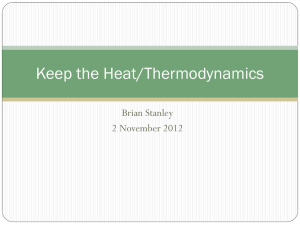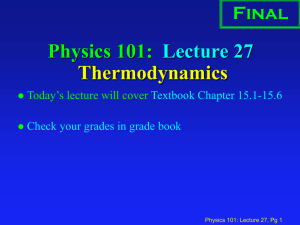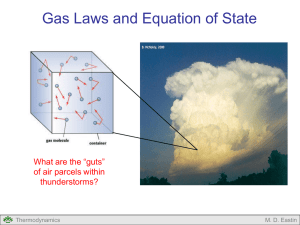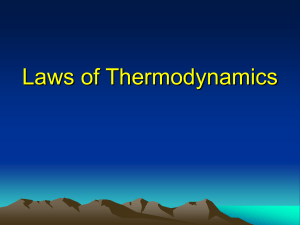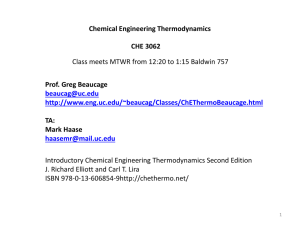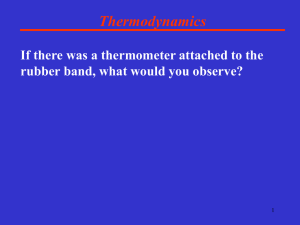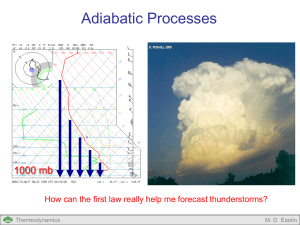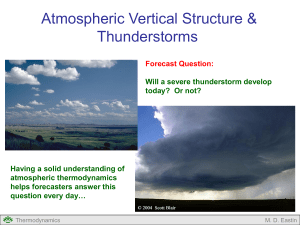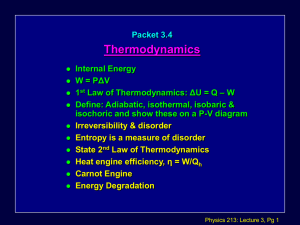First Law of Thermodynamics
advertisement
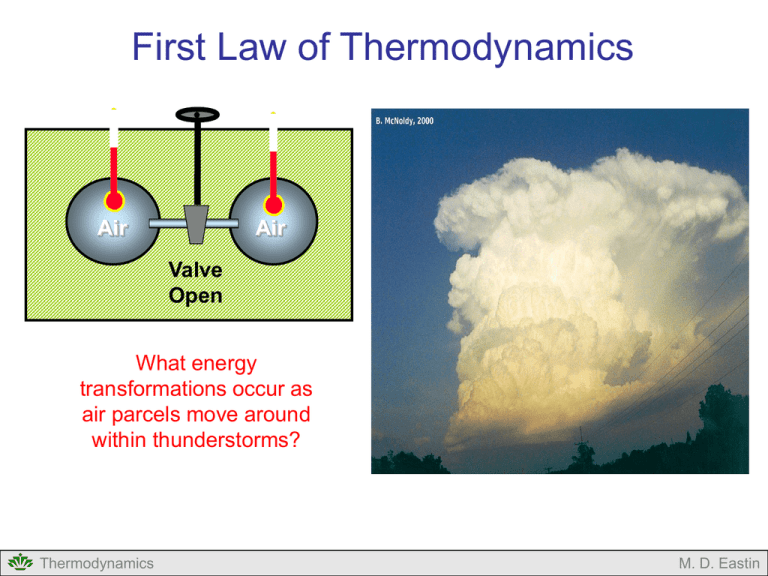
First Law of Thermodynamics Air Air Valve Open What energy transformations occur as air parcels move around within thunderstorms? Thermodynamics M. D. Eastin First Law of Thermodynamics Outline: Forms of Energy Energy Conservation Concept of Work PV Diagrams Concept of Internal Energy Joules Law Thermal Capacities (Specific Heats) Concept of Enthalpy Various Forms of the First Law Types of Processes Thermodynamics M. D. Eastin Forms of Energy Energy comes in a variety of forms… Internal Mechanical Thermodynamics Kinetic Heat Potential Chemical Electrical M. D. Eastin Energy Conservation The First Law of Thermodynamics states that total energy is conserved for any thermodynamic system → energy can not be created nor destroyed → energy can only change from one form to another Energy( E ) constant Einternal Ekinetic Epotential Emechanical Eheat Echemical Eelectrical constant Our main concern in meteorology… Thermodynamics M. D. Eastin The Concept of Work Work is a Mechanical form of Energy: Work Force Distance dW F x Force Distance x Thermodynamics M. D. Eastin The Concept of Work Work is a Mechanical form of Energy: Work Force Distance dW F x Recall the definition of pressure: Force F p Area x 2 We can thus define work as: dW pdV Thermodynamics M. D. Eastin The Concept of Work Changes in Volume Cause Work: • Work is performed when air expands F Work of Expansion: • Occurs when a system performs work (or exerts a force) on its environment • Is positive: dW 0 • Rising air parcels (or balloons) undergo expansion work • Since the environmental pressure decreases with height, with height a rising parcel must expand to maintain an equivalent pressure Thermodynamics M. D. Eastin The Concept of Work Changes in Volume Cause Work: • Similar to a piston in a car engine F Thermodynamics F M. D. Eastin The Concept of Work Changes in Volume Cause Work: • Work is performed when air contracts Work of Contraction: • Occurs when an environment performs work (or exerts a force) on a system • Is negative: dW 0 • Sinking air parcels (or balloons) undergo contraction work • Since the environmental pressure decreases with height, with height a sinking parcel must contract to maintain an equivalent pressure F Thermodynamics F M. D. Eastin Pressure-Volume (PV) Diagrams Another Way of Depicting Thermodynamic Processes: • Consider the transformation: i→f p f pf pi i Vi Thermodynamics Vf V M. D. Eastin Pressure-Volume (PV) Diagrams Another Way of Depicting Work: • Consider the transformation: i→f dW pdV f W pdV p i f pf pi i Vi Thermodynamics The work done is the area under the i → f curve (or gray area) Vf V M. D. Eastin First Law of Thermodynamics Internal Energy = Kinetic Energy + Potential Energy (of the molecules in the system) • Depends only on the current system state (p,V,T) • Does not depend on past states • Does not depend on how state changes occur • Changes are the result of external forcing on the system (in the form of work or heat) Einternal Workenvironment Heatenvironment dU dW dQ dU pdV dQ Thermodynamics M. D. Eastin Joules Law Vacuum Air Valve Closed Thermally Insulated System Thermodynamics M. D. Eastin Joules Law Air Air Valve Open Thermally Insulated System Thermodynamics M. D. Eastin Joules Law • Air expanded to fill the container • Change in volume • Change in pressure • No external work was done • Air expanded into a vacuum within the system • No heat was added or subtract • Thermally insulated system • No change in internal energy • No change in temperature Air Air Valve Open dU pdV dQ What does this mean? dU 0 Thermodynamics M. D. Eastin Joules Law • Air expanded to fill the container • Change in volume • Change in pressure • No external work was done • Air expanded into a vacuum within the system • No heat was added or subtract • Thermally insulated system • No change in internal energy • No change in temperature Internal Energy is only a function of temperature U U(T ) Thermodynamics Air Air Valve Open dU pdV dQ dU 0 M. D. Eastin Thermal Capacities (Specific Heats) Assume: A small quantity of heat (dQ) is given to a parcel The parcel responds by experiencing a small temperature increase (dT) Specific Heat (c): dQ c dT Two Types of Specific Heats: • Depends on how the material changes as it receives the heat Constant Volume: Constant Pressure: Thermodynamics dQ cv dT constant volume Parcel experiences no change in volume dQ cp dT constant pressure Parcel experiences no change in pressure M. D. Eastin Thermal Capacities (Specific Heats) Specific Heat at Constant Volume: • Starting with: • If the volume is constant (dV = 0), we can re-write the first law as: dQ cv dT constant volume dU pdV dQ • → dU dQ And substitute this into our specific heat equation as dU cv dT Thermodynamics or dU c v dT M. D. Eastin Thermal Capacities (Specific Heats) Specific Heat at Constant Volume: • Since the internal energy is a state variable and does not depend on past states or how state changes occur, we can define changes in internal energy as: T2 U c v dT T2 • Also, if we substitute our specific heat equation into the first law: dU c v dT → dU pdV dQ We can obtain an alternative form of the First Law of Thermodynamics: dQ cvdT pdV Thermodynamics M. D. Eastin Thermal Capacities (Specific Heats) Specific Heat at Constant Pressure: • Starting with dQ cp dT constant pressure and recognizing that, dQ cvdT pdV pV nR*T d(pV) pdV Vdp we can obtain another alternative form of the First Law of Thermodynamics: dQ cpdT Vdp Also, cp cv nR* Thermodynamics M. D. Eastin Concept of Enthalpy Assume: Heat (dQ) is added to a system at constant pressure Impact: 1) The system’s volume increases (V1→V2) and work is done dW p(V2 - V1 ) 2) The system’s internal energy increases (U1→U2) dU U2 - U1 Using the First Law: dQ U2 U1 pV2 V1 We can then define Enthalpy (H) as: H U pV Thermodynamics M. D. Eastin Concept of Enthalpy Enthalpy: dQ U2 U1 pV2 V1 H U pV If we differentiate the definition of enthalpy and use prior relationships, we can obtain the following relation: dQ dH cpdT We shall see that Enthalpy will be a useful concept since most sources and sinks of heating in the atmosphere occur at roughly constant pressure Thermodynamics M. D. Eastin Forms of the First Law of Thermodynamics For a gas of mass m For unit mass dQ dU dW dq du dw dQ dU pdV dq du pd dQ cvdT pdV dq cvdT pd dQ cpdT Vdp dq cpdT dp cp cv nR* cp c v R d where: p = pressure V = volume T = temperature α = specific volume U = internal energy W = work Q = heat energy n = number of moles cv = specific heat at constant volume (717 J kg-1 K-1) cp = specific heat at constant pressure (1004 J kg-1 K-1) Rd = gas constant for dry air (287 J kg-1 K-1) R* = universal gas constant (8.3143 J K-1 mol-1) Thermodynamics M. D. Eastin Types of Processes Isobaric Processes: • Transformations at constant pressure • dp = 0 p i f V Isochoric Processes: • Transformations at constant volume • dV = 0 • dα = 0 p i f V Thermodynamics M. D. Eastin Types of Processes Isothermal Processes: • Transformations at constant temperature • dT = 0 p i f V Adiabatic Processes: • Transformations without the exchange of heat between the environment and the system • dQ = 0 • More on this next lecture… Thermodynamics M. D. Eastin First Law of Thermodynamics Summary: • Forms of Energy (know the seven types) • Energy Conservation (know the basic concept) • Concept of Work (expansion and contraction in the atmosphere) • PV Diagrams (origins of an equation for Work) • Concept of Internal Energy (know the basic concept) • Joules Law (know what it implies to internal energy) • Thermal Capacities (Specific Heats) • Concept of Enthalpy (know the basic concept) • Various Forms of the First Law • Types of Processes (isobaric, isothermal, isochoric, adiabatic) Thermodynamics M. D. Eastin References Petty, G. W., 2008: A First Course in Atmospheric Thermodynamics, Sundog Publishing, 336 pp. Tsonis, A. A., 2007: An Introduction to Atmospheric Thermodynamics, Cambridge Press, 197 pp. Wallace, J. M., and P. V. Hobbs, 1977: Atmospheric Science: An Introductory Survey, Academic Press, New York, 467 pp. Thermodynamics M. D. Eastin
